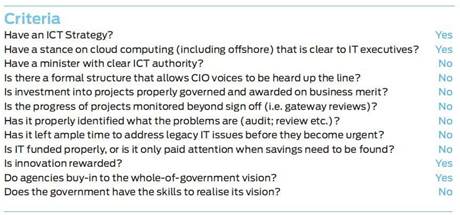South Australia's recent election featured a flood of IT policies to woo the state's voters, from linked-up justice to fingerprint scanners. Some were more thoroughly thought through than others.

Campaign chaos aside, South Australia has proved that it is not immune to the kind of optimism bias that has got so many of its fellow states into trouble.
Capping off iTnews' state government IT week, we delve deeper into the quiet IT circles of Adelaide's bureaucrats. There is quality there, but a lack of central leadership has left the state with a score of just four out of 12 on our IT maturity index:

The SA auditor-general revealed in October that the state’s shared services scheme had still yet to break even, after five years of reforms and expenditure exceeding $86 million. The shared services business case was approved based on an estimated $190 million dividend between 2008 and 2011.
In 2010, the health department underestimated the cost of its Oracle finance systems replacement by about $40 million, or two-thirds. It still hasn’t finished.
But unlike Victoria, South Australia doesn’t seem to be in any hurry to tighten its purse strings, and remains one of only two states (alongside the tightly centralised Tasmania) yet to mandate a gateway review process.
Its plan to avoid big project failures is to avoid big projects in the first place.
“From now on, we’re not going to start up any more big ‘ICT’ projects. We’re only going to have business change initiatives,” read the government’s new IT strategy in November.
“We will break these down into smaller segments, with well‑defined exit strategies that ensure that we’re not locked into spending more time and money to continue projects that aren’t working.”
Sounds good in theory. What IT manager wouldn’t be tempted to believe in a world without expensive and risky systems replacements? But without proper periodic reviews, how will the SA government know when its exit strategies need to be deployed?
No one in SA’s new or old Weatherill cabinets seems to be putting their hand up to take on the whole-of-government IT agenda, and tech policy is being made on the fly as a result.
During the election campaign, Attorney-General John Rau announced that $3 million had been spent to kit officers with yet another device to hang off their belt, despite facing the prospect of losing the election before enabling legislation could be passed.
The government won back power by a whisker, but still hasn’t commented on explosive claims of probity breaches within the health department.
So what is going right in Adelaide? There is a huge emphasis on innovation in the state, which paid big dividends several years ago when the government rolled out its common, uniform web portal. It is now recognised as the benchmark for ‘one-stop-shop’ online service delivery and NSW, Queensland and Victoria are all scrambling to emulate it.
The new strategy continues this tradition through a push for rapid prototyping and scaling, although it hasn’t set any formal targets. There is not very much money on the table, but there appears to be plenty of small initiatives going ahead anyway (PDF).
Want to see how all the states and territories stack up? Download our State of IT report. Do you work for one of these governments? Let us know how you would have scored your state here.



_(22).jpg&h=140&w=231&c=1&s=0)


_(20).jpg&h=140&w=231&c=1&s=0)





 iTnews Executive Retreat - Security Leaders Edition
iTnews Executive Retreat - Security Leaders Edition












_(1).jpg&h=140&w=231&c=1&s=0)



